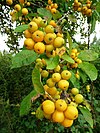bio.wikisort.org - Plant
Malus niedzwetzkyana, or Niedzwetzky's apple, is a kind of apple native to certain parts of China, Afghanistan, Kazakhstan, Kyrgyzstan, and Uzbekistan noted for its red-fleshed, red-skinned fruit and red flowers. Some botanists consider it a distinct species,[1] while others have argued it is simply an unusual variety of the common apple, Malus pumila.[2][3][4]
Niedzwetzky's apple is rare, often growing as an isolated tree, and is endangered throughout its range by agricultural encroachment and logging operations.[2] Only 111 specimens of the tree are known to survive in Kyrgyzstan. The conservation group Fauna & Flora International is working to save and restore the species in that country, and has put M. niedzwetzkyana on its endangered list, brought it under its Global Trees Campaign, and planted over 1000 saplings in area forests in 2010 and 2011[5][6]
The tree was introduced to the West c. 1890 by Georg Dieck at the Zöschen Arboretum, Germany, who grew it from seed sent by the Russian lawyer and amateur botanist Vladislav E. Niedzwiecki living in exile in Turkestan; Dieck later donated specimens to the Späth nursery, which exported the tree to the USA c. 1896.[7]
Description

The tree is winter-hardy and drought-resistant, growing 5–8 m (16–26 ft) tall in the wild (<5 m under cultivation), with a globular crown and very dark purplish-brown bark.
New shoots are dark purple, and leaves range from purplish when new to dark green when mature. In the spring it puts out intensely magenta-rose flowers that are up to 4 inches in diameter. The skin of the fruit is deep red to purple-red (sometimes with a bluish, waxy bloom) and the flesh ranges from light to bright red, with dark reddish-brown seeds.[8]
The fruit is edible and not very tart, with dry, somewhat chewy flesh.[9] In the Kashgar region of China near the Kyrgyzstan and Tajikistan borders, it is known as 'kisil alma': 'red apple'.[9]
Cultivation
Malus niedzwetzkyana has been used to breed some modern red-leaved, red-flowered, and red-fruited apples and crabapples. It is believed to be the ancestor of Surprise, a pink-fleshed apple that was brought to the United States by German immigrants around 1840 and was later used by the horticulturist Albert Etter to breed some 30 pink- and red-fleshed varieties, the best-known of which is Pink Pearl.[10] Another horticulturist, Niels Ebbesen Hansen, encountered M. niedzwetzkyana in the Ili valley, where he also met Niedzwetzky, in what was then the Russian region of Turkestan (but now Kazakhstan) during his 1897 expedition. Hansen began two breeding programs based on this unusual fruit, one aimed at developing a cold-hardy cooking and eating apple, and the other aimed at developing ornamental crabapples. His efforts resulted in the Almata apple and the Hopa crabapple, among other varieties. Some of these apples, as well as M. niedzwetzkyana itself, are being used for small-scale commercial production of rosé apple ciders.[11]
Cultivars
- 'Red Vein'.[12]
See also
- Applecrab
References
- The Plant List (version 2)
- Malus pumila in "Flora of China"
- Global Biodiversity Information Facility website
- "Malus niedzwetzkyana". Germplasm Resources Information Network (GRIN). Agricultural Research Service (ARS), United States Department of Agriculture (USDA). Retrieved 19 November 2015.
- "Garden of Eden's Orchards in Danger" Archived 2015-07-23 at the Wayback Machine
- "Conserving Threatened Apple and Pear Species in Kyrgyzstan"
- Hansen, N. How to produce that $1000 premium apple, in Minnesota State Hort. Soc. (1900). Trees, fruits & flowers of Minnesota. Vol. 28. 470-1. Forgotten Books, London, 2013. ISBN 9781153197953
- Dzhangaliev, A.D., T.N. Salova and P.M. Turekhanova. "The Wild Fruit and Nut Plants of Kazakhstan"
- Nash, George V. "Malus niedzwetzkyana". In Addisonia: Colored Illustrations and Popular Descriptions of Plants, vol. 6. The New York Botanical Garden (Addison Brown Fund), 1921, pp. 23–24.
- "The Ettersburg Apple Legacies", Greenmantle Nursery website
- "Rosé Ciders to Try This Summer"
- Moffet, L. (1931). Plumfield Nurseries Wholesale Trade List, Spring 1931.. Plumfield Nurseries, Fremont, Nebraska.
На других языках
[de] Niedzwetzki-Apfel
Der Niedzwetzki-Apfel (Malus niedzwetzkyana) ist bei einigen Autoren eine eigenständige Art aus der Gattung der Äpfel (Malus). Bei den meisten Autoren ist er aber ein Synonym für die Art Malus pumila Miller[1] oder eine Varietät Malus pumila var. niedzwetzkyana (Dieck.) C.K.Schneid. Sie kommt in Afghanistan, China, Kasachstan, Kirgisistan und Usbekistan vor. Malus niedzwetzkyana ist die wilde Stammform, die Iwan Wladimirowitsch Mitschurin 1915 benutzte, um daraus attraktive Sorten wie 'Belfler Krasny' ('Belfler Rot') oder 'Krasny Standard' (Roter Standard) zu züchten, die durch rote Blätter, rote Blüten und rote Früchte charakterisiert sind.- [en] Malus niedzwetzkyana
[ru] Яблоня Недзвецкого
Яблоня Недзвецкого (лат. Malus niedzwetzkyana) — вид растений, входящих в род Яблоня (Malus) семейства Розовые (Rosaceae).Другой контент может иметь иную лицензию. Перед использованием материалов сайта WikiSort.org внимательно изучите правила лицензирования конкретных элементов наполнения сайта.
WikiSort.org - проект по пересортировке и дополнению контента Википедии



